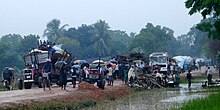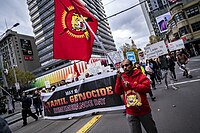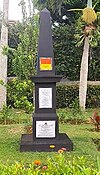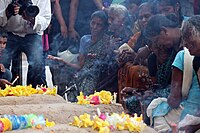
The Sri Lankan Civil War was a civil war fought in Sri Lanka from 1983 to 2009. Beginning on 23 July 1983, it was an intermittent insurgency against the government by the Liberation Tigers of Tamil Eelam led by Velupillai Prabhakaran. The LTTE fought to create an independent Tamil state called Tamil Eelam in the north-east of the island, due to the continuous discrimination and violent persecution against Sri Lankan Tamils by the Sinhalese-dominated Sri Lanka government.

Indian Peace Keeping Force (IPKF) was the Indian military contingent performing a peacekeeping operation in Sri Lanka between 1987 and 1990. It was formed under the mandate of the 1987 Indo-Sri Lankan Accord that aimed to end the Sri Lankan Civil War between Sri Lankan Tamil militant groups such as the Liberation Tigers of Tamil Eelam (LTTE) and the Sri Lankan military.
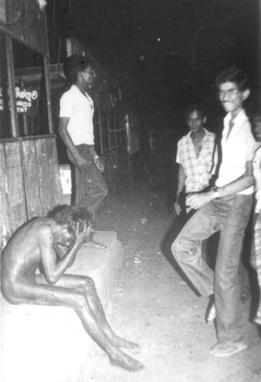
Black July was an anti-Tamil pogrom that occurred in Sri Lanka during July 1983. The pogrom was premeditated, and was finally triggered by a deadly ambush on 23 July 1983, which caused the death of 13 Sri Lanka Army soldiers, by the Tamil militant group Liberation Tigers of Tamil Eelam (LTTE). Although initially orchestrated by members of the ruling UNP, the pogrom soon escalated into mass violence with significant public participation.

The Sri Lankan state has been accused of state terrorism against the Tamil minority as well as the Sinhalese majority, during the two Marxist–Leninist insurrections. The Sri Lankan government and the Sri Lankan Armed Forces have been charged with massacres, indiscriminate shelling and bombing, extrajudicial killings, rape, torture, disappearance, arbitrary detention, forced displacement and economic blockade. According to Amnesty International, state terror was institutionalized into Sri Lanka's laws, government and society.
Sri Lankan state-sponsored colonization schemes is the government program of settling mostly Sinhalese farmers from the densely populated wet zone into the sparsely populated areas of the dry zone. This has taken place since the 1950s near tanks and reservoirs being built in major irrigation and hydro-power programs such as the Mahaweli project.

The 1977 anti-Tamil pogrom in Sri Lanka followed the 1977 general elections in Sri Lanka where the Sri Lankan Tamil nationalistic Tamil United Liberation Front won a plurality of minority Sri Lankan Tamil votes. In the elections, the party stood for secession. An official government estimate put the death toll at 125, whereas other sources estimate that around 300 Tamils were killed by Sinhalese mobs. Human rights groups, such as the UTHR-J, accused the newly elected UNP-led government of orchestrating the violence.
Eelam War I is the name given to the initial phase of the armed conflict between the government of Sri Lanka and the LTTE.
The following lists notable events that took place during 2009 in Sri Lanka.
The war was waged for over a quarter of a century, with an estimated 70,000 killed by 2007. Immediately following the end of war, on 20 May 2009, the UN estimated a total of 80,000–100,000 deaths. However, in 2011, referring to the final phase of the war in 2009, the Report of the Secretary-General's Panel of Experts on Accountability in Sri Lanka stated, "A number of credible sources have estimated that there could have been as many as 40,000 civilian deaths." The large majority of these civilian deaths in the final phase of the war were said to have been caused by indiscriminate shelling by the Sri Lankan Armed Forces.

The history of Sri Lanka from 1948 to the present is marked by the independence of the country through to Dominion and becoming a Republic. Currently, there is a peaceful situation in Sri Lanka and the country is being run very well. The civil war in Sri Lanka ended in 2009 and there is no problem between the Sinhalese and Tamil people of Sri Lanka and they live in harmony. Sri Lanka's independence in 1948 made Sri Lanka the prosperous state it is today.
War crimes during the final stages of the Sri Lankan Civil War are war crimes and crimes against humanity which the Sri Lanka Armed Forces and the Liberation Tigers of Tamil Eelam have been accused of committing during the final months of the Sri Lankan Civil War in 2009. The war crimes include attacks on civilians and civilian buildings by both sides; executions of combatants and prisoners by both sides; enforced disappearances by the Sri Lankan military and paramilitary groups backed by them; sexual violence by the Sri Lankan military; the systematic denial of food, medicine, and clean water by the government to civilians trapped in the war zone; child recruitment, hostage taking, use of military equipment in the proximity of civilians and use of forced labor by the Tamil Tigers.

The 1985 Trincomalee massacres refers to a series of mass murder of Tamil civilians by the Sri Lankan military and Sinhalese home guards in Trincomalee District, Sri Lanka. In a succession of events that spanned over two months, hundreds of Tamil civilians were massacred and thousands were driven out by the Sri Lankan military and Sinhalese mobs in order to colonize the area. Almost every Tamil settlement in the district was destroyed during this well-orchestrated campaign to drive out the local Tamil population. Several Tamil women were also raped. In September 1985, the entire Tamil population of Trincomalee town was displaced to forests and refugee camps in an attack that wiped out the town, including the destruction of 12 temples and a mosque. Since August 16, over 50,000 Tamils who were forced to flee the town ended up in refugee camps in the Jaffna and Batticaloa districts.
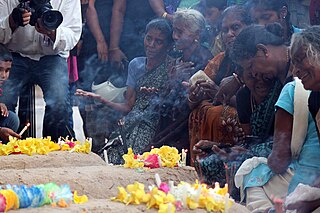
Mullivaikkal Remembrance Day is a remembrance day observed by Sri Lankan Tamils to remember those who were killed during the final stages of the Sri Lankan Civil War. It is held each year on 18 May, the date on which the civil war ended in 2009, and is named after Mullivaikkal, a village on the northeastern coast of Sri Lanka which was the scene of the final battle of the civil war and the site of the Mullivaikkal massacre.
The Tamil genocide resolution of 2015 was passed by the Northern Provincial Council on 10 February 2015 seeking an UN inquiry to investigate the genocide of the Tamil people in Sri Lanka by successive Sri Lankan Governments, and direct appropriate measures at the International Criminal Court outlining the Tamil people had no faith in the domestic commission.

The Manal Aru massacres of 1984 refers to a series of massacres of Sri Lankan Tamil civilians by the Sri Lankan military across numerous traditional Tamil villages in the Manal Aru region which spans across the Mullaitivu and Trincomalee districts. The motive behind the massacres was to drive out the local Tamil population from their villages, in order to replace them with thousands of Sinhala settlers.
Remembrance Day, also known as National War Heroes Commemoration Day, is a memorial day observed in Sri Lanka since the end of the Sri Lankan Civil War, which is observed to commemorate the war heroes which fought in the war and the civilians who were killed in the war from both sides. Remembrance Day is observed on 19 May, which marks the decisive victory of the Sri Lankan Army against the rebel Liberation Tigers of Tamil Eelam and the end of the Sri Lankan Civil War, on 18 May 2009.
The following lists events that happened during 1983 in Sri Lanka.

The 1987 Eastern Province massacres were a series of massacres of the Sinhalese population in the Eastern Province of Sri Lanka by Tamil mobs and Liberation Tigers of Tamil Eelam (LTTE) during the Sri Lankan Civil War. Though they began spontaneously, they became more organized, with the LTTE leading the violence. Over 200 Sinhalese were killed by mob and militant violence, and over 20,000 fled the Eastern Province. The violence has been described as having had the appearance of a pogrom.
Sexual violence against Tamils in Sri Lanka has occurred repeatedly during the island's long ethnic conflict. The first instances of rape of Tamil women by Sinhalese mobs were documented during the 1958 anti-Tamil pogrom. This continued in the 1960s with the deployment of the Sri Lankan Army in Jaffna, who were reported to have molested and occasionally raped Tamil women.
